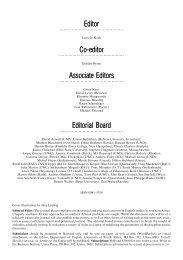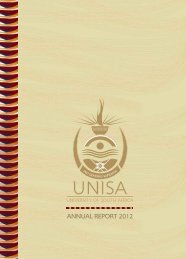pdf: 6.426kb - University of South Africa
pdf: 6.426kb - University of South Africa
pdf: 6.426kb - University of South Africa
You also want an ePaper? Increase the reach of your titles
YUMPU automatically turns print PDFs into web optimized ePapers that Google loves.
<strong>South</strong> <strong>Africa</strong>n Navy participates in fleet<br />
review commemorating 500th anniversary<br />
<strong>of</strong> the discovery <strong>of</strong> Brazil<br />
by Keith Cambell<br />
Political analyst and journalist<br />
The <strong>South</strong> <strong>Africa</strong>n Navy's hydrographic ship, SAS<br />
Protea, was one <strong>of</strong> 29 ships from eleven nations<br />
which participated in a fleet review in Guanabara Bay,<br />
Rio de Janeiro, on 30 April 2000, as part <strong>of</strong> festivities<br />
to mark the 500th anniversary <strong>of</strong> the discovery <strong>of</strong><br />
Brazil. The Protea left the <strong>South</strong> <strong>Africa</strong>n Navy's main<br />
base at Simonstown, south <strong>of</strong> Cape Town, on 14<br />
April, arriving in Rio on 26 April. The captains <strong>of</strong> all<br />
the ships participating in the review were briefed on<br />
the morning <strong>of</strong> 28 April, on such matters as the route<br />
to be followed, the order <strong>of</strong> ships in the review, and so<br />
on.<br />
The review fleet included modern warships, naval<br />
auxiliaries, sail training ships, and replicas <strong>of</strong> 15th/<br />
SAS Protea participating in the fleet review<br />
16th century Portuguese vessels. Apart from <strong>South</strong><br />
<strong>Africa</strong>, the foreign countries participating were the<br />
US, which sent a frigate, the UK, with a destroyer and<br />
tanker, Venezuela, with a frigate and a tank landing<br />
ship, Argentina, Spain and the Netherlands, each <strong>of</strong><br />
which was represented by a frigate, Poland, whose<br />
representative was a training ship, Uruguay, with a sail<br />
training ship, and <strong>of</strong> course Portugal, which sent a<br />
couple <strong>of</strong> replica sailing vessels and its Navy's sail<br />
training ship, the Sagres. Apart from four sailing<br />
vessels ± three civilian and the Navy's new sail training<br />
ship Cisne Branco ± the Brazilian Navy contingent<br />
comprised one destroyer, five frigates, a corvette, a<br />
submarine, a tank landing ship, a survey ship, and a<br />
museum ship. In addition, nine helicopters participated<br />
in a fly-past.<br />
The review took the form <strong>of</strong> a sail past, with the<br />
ships in line-ahead formation and divided into two<br />
divisions. The first division comprised a Brazilian<br />
frigate (which was in the lead) followed by the eight<br />
sailing ships (or tall ships as they are nowadays<br />
called). Then there was the helicopter flypast, and<br />
finally the sail past <strong>of</strong> the modern naval vessels.The<br />
salute was taken by Brazilian President Fernando<br />
Henrique Cardoso, from a review stand at the Escola<br />
Naval in Rio de Janeiro.<br />
Captain L D Reeder, commander <strong>of</strong> the Protea,<br />
reported that his crew had been proud to represent<br />
<strong>South</strong> <strong>Africa</strong> at the review and enjoyed themselves<br />
thoroughly. The reception received by the ship in<br />
72 ISSN 0256±6060±Unisa Lat. Am. Rep. 16(2) 2000

















